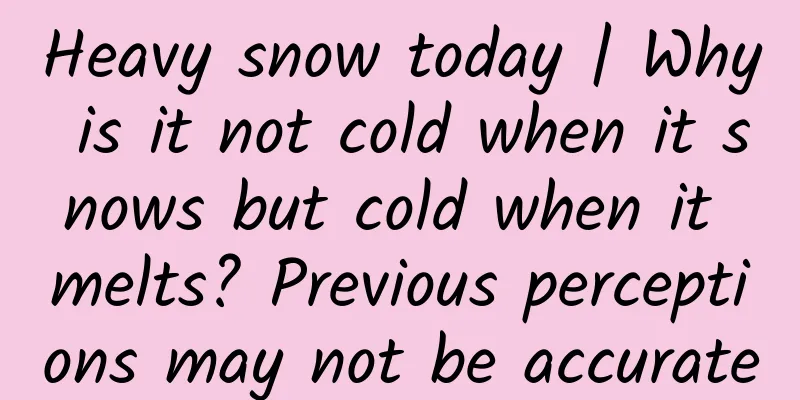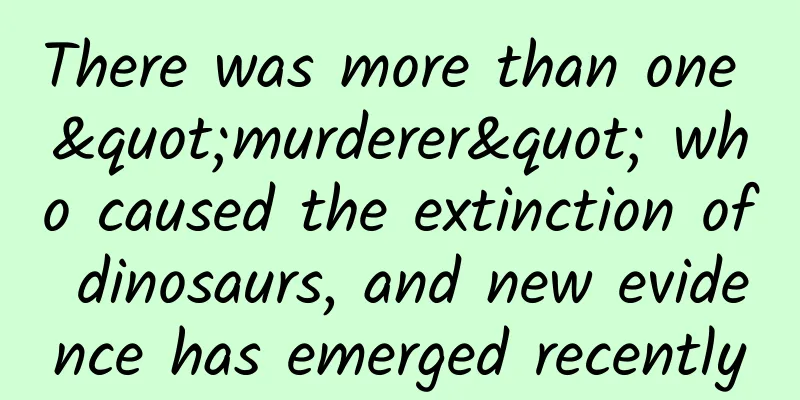Heavy snow today | Why is it not cold when it snows but cold when it melts? Previous perceptions may not be accurate

|
The Big Snow solar term is the 21st solar term in the 24 solar terms of the lunar calendar and the third solar term in winter. It marks the official start of mid-winter. The temperature in most parts of my country will drop significantly, and the lowest temperature in some northern regions will even drop below 0℃. In areas where the cold and warm air clash at the front of the strong cold front, there will be heavy snowfall or even blizzards. The Big Snow solar term has become an important climate turning point, marking a significant drop in temperature and an increase in precipitation, reflecting the increase in snowfall. The picture is a copyrighted stock picture. Reprinting it may cause copyright disputes. As this solar term approaches, let’s talk about a question that everyone seems to know the “correct answer” to: Why is it not cold when it snows, but cold when the snow melts? Some people may say: Isn’t this just “snow forming releases heat, snow melting absorbs heat”? Is that really true? Tourists enjoy the snow scenery at the Mingsha Mountain and Crescent Lake scenic area. Xinhua News Agency (Photo by Zhang Xiaoliang) 01Snow releases heat When water vapor cools in the air and condenses into snowflakes, this process releases heat, called the heat of condensation . This released heat forms a tiny warm layer around the snowflakes, and although this warming effect is relatively weak, it slows down the cooling of the surrounding environment after the snowflakes fall to the ground to a certain extent. In addition, snowfall is usually accompanied by cloud cover, which acts like a blanket to reduce the amount of heat lost to the atmosphere from the ground. This is the common explanation for “it’s not cold when it snows”. Snow scene in Beijing's Nanhaizi Park (Photo source: Xinhua News Agency) 02Snow melting absorbs heat When snow changes from a solid to a liquid state, it absorbs heat, a process known as the heat of fusion . This means that heat from the surrounding environment is absorbed by the snow to complete its phase change, causing the ambient temperature to drop. When snowfall ends and there are few or no clouds in the sky, the ground is able to radiate heat into the atmosphere more efficiently as the snow melts without cloud cover, further exacerbating the cooling effect. This is the usual explanation for “melting snow brings coldness”. After the heavy snow, sanitation workers are clearing snow on the road (the picture is a copyrighted picture, and reprinting may cause copyright disputes) 03Causation Is it correct to explain the reason why “it’s not cold when it snows, but it’s cold when it melts” as “snow releases heat when it forms, and snow absorbs heat when it melts”? No! Let's deduce this statement logically. Even if latent heat is released when snow falls, or cloud cover creates a warming effect, the temperature must be below 0℃ when snow forms. If the temperature does not fall below 0℃, it will not snow. Even if the snow absorbs heat when it melts, or the heat dissipation is enhanced due to the lack of cloud cover, the temperature must be above 0℃ when the snow melts. If the temperature does not reach above 0℃, it will not melt. From this, we can infer that the temperature is below 0℃ when it snows, and above 0℃ when it melts. So, the temperature when the snow forms is lower than when it melts, which means "it is not cold when the snow melts, but it is cold when it snows." Therefore, it is problematic to explain "it is not cold when the snow melts, but it is cold when it snows" by saying "snow forms and releases heat, but snow melts and absorbs heat." “Snow releases heat when it forms, and snow melts absorbs heat” is not wrong, and “it’s not cold when it snows, but it’s cold when it melts” is not wrong either. So what’s the problem? “Snow releases heat when it forms, and snow melts absorbs heat” is not the reason why “it’s not cold when it snows, but it’s cold when it melts”. The two do not constitute a causal relationship. Snow scene at Shougang Park (Photo source: Xinhua News Agency) 04Root Cause Since the common belief that "snow releases heat and snow melts absorbs heat" is not the fundamental reason why "it is not cold when it snows but it is cold when it melts", then what makes us feel that "it is not cold when it snows but it is cold when it melts"? In the final analysis, the fundamental reason why "it is not cold when it snows but it is cold when it melts" comes from humidity. In daily life, we pay more attention to the meteorological element of temperature, and do not pay much attention to humidity. The so-called humidity usually refers to the content of water vapor in the air . There is a great relationship between humidity and human body temperature: when the ambient humidity is high, the moisture content in the air increases, which will hinder the evaporation rate of the skin, and the evaporation of sweat will slow down, making it difficult for the human body to dissipate heat. The effectiveness of evaporative cooling is inhibited because the water vapor in the air is close to saturation and sweat is difficult to evaporate, causing the body to feel stuffy and hot, and then feel that the ambient temperature is high. On the contrary, when the ambient humidity is low, sweat evaporates easily, which can effectively take away the heat from the skin, making people feel that the ambient temperature is low, which helps to cool the body and feel cooler. We know that in a high humidity and high temperature environment, people will feel stuffy, which is commonly known as a "sauna day", but what is the relationship between cold and humidity? In a cold environment with high humidity, due to the high water vapor content in the air, the heat dissipation of the human body is hindered, and the evaporation of sweat slows down, resulting in a lower perceived temperature, which intensifies the feeling of cold. In addition, high humidity may also cause moisture condensation between clothing and skin, further reducing the warmth effect. When it snows, a large amount of water molecules in the air become solid snow or ice particles, and the humidity of the air decreases. When the snow melts, a large amount of snow water evaporates and escapes into the air, and the humidity of the air increases. Although the temperature is slightly above 0℃ when the snow melts, the high humidity makes people feel colder. When it snows, the temperature is slightly below 0℃, and because the water vapor in the atmosphere is taken away by the snowflakes, the relatively dry air makes people feel less cold. Although the atmospheric temperature of melting snow is higher than that of snowfall, melting snow feels colder to the human body due to humidity. A child plays on the snow at Tianjin Water Park (Photo: Xinhua News Agency) 05Conditional Cold Nothing is absolute, it also depends on the season and the region. It is not always true in all regions that "it is not cold when snowing but cold when snowing melts". The comparison we made was made when the temperature was around 0℃ when snowing and melting, which is not true in all cases. In early winter, especially when the first snowfall comes, the temperature is only slightly below freezing, so it won't feel very cold when it snows, and it will be even colder when the snow melts. However, if you reach the northern region in the dead of winter, the temperature is far below 0℃, even reaching below minus 20℃, and it will be very cold as long as it snows. When spring is about to arrive, the temperature is slightly above 0℃, and we will feel a little cold when the snow melts. But if the temperature is much higher than 0℃, the breath of spring is blowing in, and what melts is only the remaining snow from winter, and we will not feel cold. Author: Wang Yuanhong, Senior Weather and Climate Engineer Produced by: Science Popularization China |
>>: Ibuprofen, the pain "savior", are you really familiar with it?
Recommend
Qingming Outing Season | How to have fun in the wild safely? Check out these emergency tips!
Audit expert: Luo Huachun Editor-in-Chief of Citi...
"Mr. Chen's Marriage Class" is a very popular course on Tik Tok
"Mr. Chen's Marriage Class" is a ve...
Virtuality or reality is not important, promoting economic development is king
Recently, various opinions have emerged on the de...
New energy and overseas sales have grown steadily. Self-owned brands account for more than 60% of sales. In April, SAIC Group sold 360,000 vehicles.
(May 10, 2024, Shanghai) Today, SAIC Motor releas...
How to design a popular short video script?
What is the most popular thing nowadays? Of cours...
Experience in attracting new customers through marketing activities
Many activities seem to have been done, and time ...
The most detailed explanation of the latest Apple developer account application in 2016!
Preparation: a credit card that supports VISA or ...
18 tips for writing a good beginning and ending for a public account article!
A few days ago, I saw someone say on Zhihu: "...
A stroke left her speechless for 18 years, AI + brain-computer interface helps her “speak with thoughts”
Speaking is the most basic ability and method of ...
"Blue Tears" is about to enter its peak period! Make these preparations to avoid wasted trips!
On the evening of March 17, level 3 blue tears ap...
New brand marketing model!
Currently, almost all companies have guidance on ...
Meizu MX5 hands-on experience with full metal body
Meizu, which releases new phones at a rapid pace,...
Baidu Search Bidding Promotion Operation White Paper
Paid bidding promotion has always been an importa...
How do experienced operators operate their business?
1. What do I look for when recruiting operations ...
Analysis of Tik Tok’s refined operation and promotion techniques!
The author of this article analyzes Douyin’s pers...









